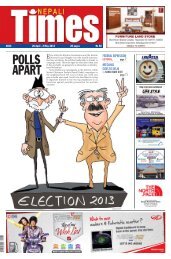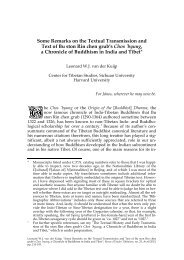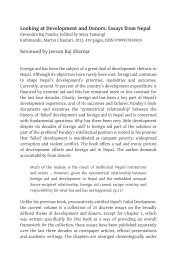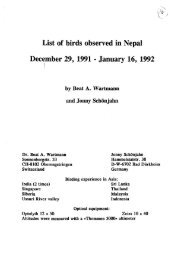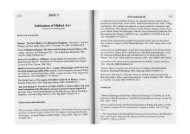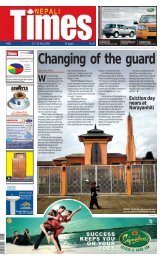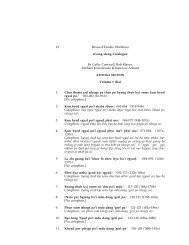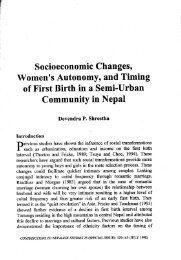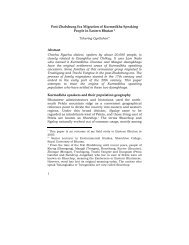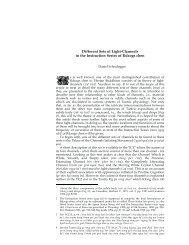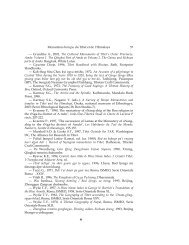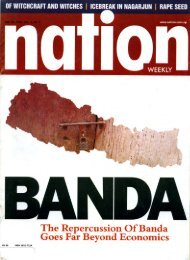Nepali Times - Digital Himalaya
Nepali Times - Digital Himalaya
Nepali Times - Digital Himalaya
You also want an ePaper? Increase the reach of your titles
YUMPU automatically turns print PDFs into web optimized ePapers that Google loves.
2 EDITORIAL 3 - 9 NOVEMBER 2000 NEPALI TIMES<br />
THE TEN-YEAR ITCH<br />
The Constitution of the Kingdom of Nepal 2047 (1990) has been<br />
criticised by a vocal minority on all sides of the political spectrum. The<br />
right claims it is against <strong>Nepali</strong> nationhood because the divine<br />
powers of the king have been curtailed. The left says its ambiguous<br />
provisions are open to manipulation by traditionalists and<br />
reactionaries. Extremists ridicule it as a document that compromised<br />
the real interests of the people after the Jana Andolan.<br />
To be sure, this first decade has been a roller-coaster ride: three<br />
parliaments, ten prime ministers, two local elections, improbable<br />
coalitions, perennial infighting, break-ups of political parties, and a<br />
tendency to polarise. No wonder some call the system of government<br />
in Nepal today “constitutional anarchy”.<br />
But there have been achievements: the supremacy of the law was<br />
proven when the Supreme Court restored the second Pratinidhi<br />
Sabha in 1995, even though it had been dissolved earlier on the<br />
recommendation of the prime minister. Taking advantage of the<br />
unfettered freedom of expression and organisation, there has been a<br />
transformation in social activism, media and civil society. Given the<br />
persisting stranglehold of superstition and fatalism in this country<br />
(not necessarily confined to the illiterate), this is no mean feat.<br />
Apart from all that, the 1990 Constitution made a dramatic break<br />
from the past—it transferred sovereignty from the crown to the people.<br />
The symbol of <strong>Nepali</strong> nationalism and unity is now the Constitution.<br />
So what’s so great about that, you may ask. Well, it puts the onus of<br />
building our future on our own shoulders. We can no longer blame it<br />
on fate, or callous rulers. If our leaders turn out to be crooks, we have<br />
the power to vote them out.<br />
There is an opportunity to start anew as we prepare to mark the<br />
first ten years of our constitution. Informal talks were held last week<br />
between the Deputy Prime Minister Ram Chandra Paudel, and the<br />
representative of a group that doesn’t believe in the present<br />
constitution and has adopted a violent struggle to have it changed.<br />
Hopes have been raised that there is now light at the end of this dark<br />
tunnel. All right-thinking <strong>Nepali</strong>s in their heart of hearts are convinced<br />
this is the way to go. The sooner the Maoists use the political space<br />
afforded by the same constitution they revile to enter the mainstream,<br />
the better it will be for them and for the <strong>Nepali</strong> people. But after living<br />
by the bullet, do they have the political will to face the ballot? The<br />
<strong>Nepali</strong> people have such a low opinion of political leaders who have<br />
ruled us so far that the Maoists may be pleasantly surprised to win the<br />
next election.<br />
Sceptics have already begun to rubbish the informal talks as a<br />
Maoist propaganda ploy. But if they are sincere, and we have Padma<br />
Ratna Tuladhar’s word that they are, perhaps they discovered its<br />
usefulness only after the possibility of the army coming under the<br />
constitutionally formed government of the day became imminent.<br />
<strong>Nepali</strong>s now have to show they are mature enough to control their<br />
destiny. After all, they are in charge.<br />
THE ORIFICE<br />
OK, everyone, back to work. The fun and<br />
games are over for now. Or, are they? By the<br />
looks of it, we are headed for another four-day<br />
forced holiday, 16-20 November, to protest the<br />
fuel price hike. With a work ethic like that, it is<br />
a wonder that this country hasn’t completely<br />
disappeared off the face of the earth.<br />
Even at the best of times, official office<br />
time is nine. You saunter in around ten,<br />
nobody even notices because none of the<br />
colleague is there to notice; they come in at<br />
eleven. Just in time for the first round of tea<br />
on the terrace, to reminisce about the Tihar<br />
winnings. Or bitch about local transport: the stinking three-wheelers<br />
that run on kitchen gas, the diesel buses that run on kerosene, the<br />
Bajaj whose meter gallops faster than a four-wheel taxi, a microbus<br />
that is packed like a sardine can, the high-handiness of transport<br />
cartels.<br />
An office is where the <strong>Nepali</strong> civil servant goes to relax, to get away<br />
from the tedium of housework. It all becomes a bit suspicious when<br />
someone is seen to be actually working these days. Why is he in his<br />
office, poring over files? What’s in it for him? Why the motivation. is he<br />
on the take? The only honest civil servants these days may be the<br />
ones out on the terrace having tea. It’s better than working for a living.<br />
<strong>Nepali</strong> <strong>Times</strong> is published by Himalmedia Pvt Ltd<br />
Mailing address: GPO Box 7251 Kathmandu Nepal<br />
Editor: Kunda Dixit Desk editors: Deepak Thapa, Samuel Thomas<br />
editors@nepalitimes.com<br />
Marketing, circulation and subscriptions: (01) 543333-7 Fax: (01) 521013<br />
marketing@nepalitimes.com www.nepalitimes.com<br />
Printed at Jagadamba Press (01) 521393<br />
BOOK REVIEW<br />
by KUNDA DIXIT<br />
Kingdoms in cloud-cuckoo-land<br />
A benign king is preferable to the overhasty adoption of an already corrupted<br />
version of democracy, says the author of a new book on <strong>Himalaya</strong>n kingdoms.<br />
When writer Jonathan Gregson was<br />
born in India, there were four<br />
<strong>Himalaya</strong>n kingdoms: Tibet,<br />
Bhutan, Nepal and Sikkim. And from<br />
childhood, Gregson had a fascination for these<br />
mountains, a fascination nurtured by the<br />
<strong>Nepali</strong> orderlies who talked about home, by<br />
summer holidays in Darjeeling looking out at<br />
the mountains of Nepal, Sikkim and Bhutan,<br />
and by a boyhood friendship with Prince<br />
Jigme Singye Wangchuk at school in Calcutta.<br />
What Gregson has tried to do in<br />
Kingdoms Beyond the Clouds: Journeys in Search<br />
of the <strong>Himalaya</strong>n Kings is pick up vestiges of<br />
this allure for all things <strong>Himalaya</strong>n and find a<br />
chord that runs through them: the god-kings<br />
of the <strong>Himalaya</strong>. Fifty years later, only two of<br />
these kingdoms remain: Nepal and Bhutan.<br />
The geopolitical might of the region’s two<br />
superpowers, India and China, had obliterated<br />
Sikkim and Tibet. Gregson, meanwhile, had<br />
turned into a travel writer, trotting around the<br />
world doing postcard journalism to fill the<br />
pages of papers back home.<br />
Kingdoms Beyond the Clouds is a 500-page<br />
saga of Gregson’s search for constitutional<br />
monarchs, shy kings revered as gods by their<br />
subjects, and the descendants of others whose<br />
kingdoms have disappeared. But tracking<br />
down these kings (even his former classmate<br />
who by now is King of Bhutan) and then<br />
pinning them down for interviews, however,<br />
seemed as difficult as trying to find the yeti.<br />
But here they are: the Dalai Lama, King<br />
Birendra of Nepal, King Jigme Singye<br />
Wangchuk of Bhutan, ‘Prince’ Wangchuk,<br />
the present ‘Chogyal’ of Sikkim, and last but<br />
not least, the Mustangi Raja Jigme Dorje<br />
Palbar Bista.<br />
Inevitably, given Gregson’s background as<br />
a travel writer, Kingdoms Beyond the Clouds<br />
belongs to a genre of semi-journalistic travelogues<br />
in the half-way world between serious<br />
research and a piece in the travel section of<br />
the Sunday Independent. Although Gregson is<br />
not as bad as some of the others, we really<br />
can’t seem to get away from these patronising<br />
parachute essayists who expose their<br />
ethnocentrism. For example, how does<br />
describing Krishna Prasad Bhattarai and King<br />
Birendra as “looking like Tweedle Dum and<br />
Tweedle Dee” because they are both dressed<br />
in daura suruwal, coat and topi give us any<br />
extra insight into Nepal’s constitutional<br />
monarchy? But it has to be granted that some<br />
of Gregson’s barbs at King Birendra’s<br />
secretaries are richly deserved, and his description<br />
of their devious obtuseness hits the mark.<br />
The three chapters in Kingdoms Beyond the<br />
Clouds that deal with Nepal will be rewarding for<br />
<strong>Nepali</strong> readers because of the rare glimpse it gives<br />
into the inner workings of the Royal Palace in<br />
Kathmandu, and perhaps also into the mind of<br />
the monarch himself. (See facing page.)<br />
Gregson is intrigued about how King<br />
Birendra, vilified during the Jana Andolan for<br />
vacillating on restoring democracy, has now reearned<br />
the respect of the <strong>Nepali</strong> people. “King<br />
Birendra has reinvented himself as the model<br />
constitutional monarch,” he writes, “…What<br />
really puzzled me was how to reconcile the<br />
benign, ever-smiling monarch I had just met with<br />
the bogeyman depicted in so many accounts of<br />
the 1990 Revolution.” He goes on to say that by<br />
taking a step back from the political arena, the<br />
monarchy is no longer held responsible for<br />
Nepal’s disorderly transition to democracy. He<br />
concludes: “Perhaps for these very reasons, (the<br />
monarchy) is better loved…the system of<br />
monarchy is so deeply entrenched that it would<br />
take a far greater upheaval than the Jana Andolan<br />
to turn most Nepalese into republicans.”<br />
It is about the Jana Andolan itself that<br />
Gregson has some unconventional views. He<br />
concludes that the scale of the uprising was<br />
exaggerated, it was confined to Kathmandu and<br />
that the anti-monarchist turn of the demonstrations<br />
was not spontaneous but “carefully<br />
orchestrated”. Then he goes on to say that<br />
compared to most other popular revolutions, “the<br />
Jana Andolan was a pushover. It was almost too<br />
easy a victory.” Compared to what, Jonathan,<br />
Tiananmen Square? There is really no need to<br />
compare Kathmandu 1990 to Rangoon 1988 or<br />
Beijing 1989. By <strong>Nepali</strong> standards, these were<br />
unprecedented street demonstrations, with<br />
unprecedented and seriously escalating violence.<br />
It is to King Birendra’s credit that he saw the<br />
writing on the wall and began the process of<br />
consultations that led to the transitional<br />
government and the new constitution.<br />
The two Jigmes in the book, the<br />
Mustangi Raja and the King of Bhutan, seem<br />
to wear their crowns with unease. The<br />
Mustangi Raja comes across as a simple,<br />
likeable man who is comfortable with his<br />
status in the “kingdom within a kingdom”.<br />
Yet, there are rumblings. Mainly from the<br />
bulldozers building a new road from the<br />
Chinese border to Lo Manthang. He doesn’t<br />
like the road, but has no power to stop it.<br />
Gregson goes to Bhutan twice in search<br />
of the classmate he played tag with and is<br />
treated, well, royally. He doesn’t therefore<br />
probe too deeply into the real reasons for the<br />
Bhutanese refugee crisis, and lets King Jigme<br />
off the hook when he is told that the<br />
Lhotsampas voluntarily left Bhutan attracted<br />
by the free food and lodging in the refugee<br />
camps in Jhapa. International observers of<br />
Bhutan who like to think King Jigme is being<br />
pushed by hardliners in his fold, and that the<br />
monarch himself is a moderate, will find his<br />
statements a revelation. The king repeats the<br />
radical Bhutanese position of blaming Nepal<br />
for the crisis. What is it about Bhutanese<br />
officials that they can only say how well their<br />
country is doing by putting Nepal down?<br />
Gregson falls into this trap, too, and in his<br />
praise for exclusive $200-a-day tourism,<br />
snobbishly trashes Thamel and Nagarkot,<br />
glossing over the enormous benefit trekking<br />
has been as employment generation and<br />
income to the <strong>Nepali</strong> countryside.<br />
Gregson gives a hint about which side<br />
his sentiments lie when in the epilogue, he<br />
concludes: “...in certain stages of a country’s<br />
development, a benign king is preferable to<br />
the overhasty adoption of an already<br />
corrupted version of democracy.” So, now<br />
we know: the author is from the “Singapore<br />
school”. Gregson seems to have done his<br />
homework on recent <strong>Nepali</strong> history, so he<br />
should have known that we did try the<br />
“guided democracy” model for 30 years, and<br />
that didn’t work either. Nepal’s democratically-elected<br />
leaders after 1990 have<br />
squandered their own hard-earned freedoms,<br />
they have insulted the <strong>Nepali</strong> people by<br />
frittering away the gains. But it is also true<br />
that many of the roots of abuse were laid<br />
during the Panchayat years. Let’s not blame<br />
democracy for the misdeeds of venal and selfserving<br />
politicians. Unless Gregson is trying<br />
to say that democracy is not good for poor<br />
countries, and is meant only for rich ones in<br />
Europe which have had two centuries of<br />
practice. t




